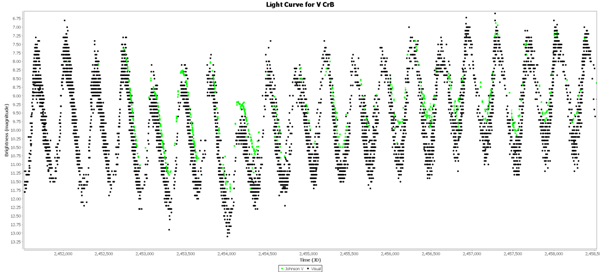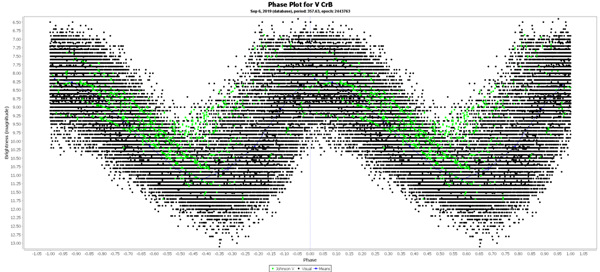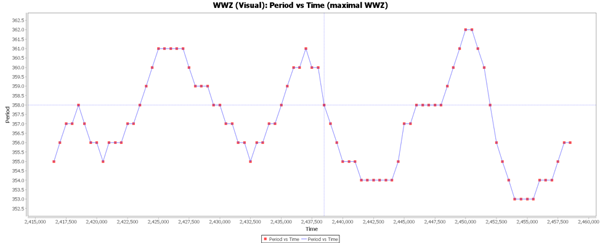V CrB
by Rich Roberts
V Crb (15 49 31.31 +39 34 17.9, J2000) is a peculiar orange-red carbon-star (C6,2e (N2e)) with a long history of AAVSO coverage. Since V CrB recently became an asymptomatic giant branch star, it is currently in its hydrogen shell and helium shell burning stage of life. V CrB is in the legacy LPV program and Percy’s list of pulsating red giants (PRGs) exhibiting unusual behavior. The AID currently holds 34,114 observations by 1248 different observers since 1904. 88.7% of the V CrB observations are visual. Although observations in Johnson V have picked up since 2003, very few complete cycles are recorded in this band. V CrB is almost 14 degrees north of Alphecca and thus placed well outside the Northern Crown at the border regions of Hercules, Bootis, and Coronae Borealis. It can be found by following a line from Arcturus, to Izar, to Delta Boo, to V CrB. Since it is located in a sparse star field, making accurate estimates can be a challenge, especially when it is near maximum. VSX lists V CrB’s magnitude range as 6.9 V to 12.6 V. With a 1 degree FOV chart, the brightest comp star is only 9.6. Expanding to a 2 degree field will bring in three different 8th magnitude stars. So when V CrB is bright, binocular observations are important for making good estimates. A 5 degree binocular chart will give you comps at 7.5, 6.9, and 5.4 a few degrees south of V CrB.
Marsakova (1999) studied the mean brightness variation of 16 carbon Miras and found they are cyclic with a super-period of 10 times the normal period. Maraskova noted that V CrB exhibited a decreasing minimum and maximum in all bands and found that V CrB had the strongest variations of the Miras studied. V CrB was the only star to exhibit both cyclic and decreasing brightness in the study. Most other stars exhibited one of the other. By looking at their chart, which included data from 1927 to 1995, the trend is clearly evident.

However, if you look pull “all data” into VStar, you can see that the Marsakova (1999) data started at a top. Around JD 2450000 (1995), and thus shortly after this paper was published, the mean brightness of V CrB seems to rise and then steady back out. This exhibits the importance of continued monitoring of LPVs. They can exhibit changes in behavior over very long time scales.

V CrB’s cyclical min/max variations can be seen with the below light curve, which is the star’s last 20 cycles.

VSX lists the period as 367.63 days which is the same result received by running a DCDFT wit period range in VStar.

V CrB’s period does meander over time for a high of 361.5 days to a low of 353 days, which is very typical for carbon stars. V CrB’s period fluctuations are relatively minor compared to other similar stars, which can vary by as much as 5% from the mean.

Kipper (1998) analyzed the chemical composition of V CrB and found it to be very similar to other late type CH stars. CH stars are moderately aged halo population II (first generation, metal deficient) stars with very strong methylidyne (CH) absorption lines. The stellar atmosphere contains several carbon molecules, such as: CO, CN, C2, HCN, C2H2, and C3. Kipper’s modeling of V CrB also found that no graphite dust shell is needed, as proposed by Goebel et al. (1981), to explain the star’s spectrum. He also found V CrB to undergo very mild shock waves and has a low mass loss rate (2x107 solar mass/year) for a carbon star. Libert et al. (2018) also studied the mass loss of V CrB and came up with a similar rate as Kipper. Libert et al. went a step further to determine V CrB has only been losing mass for about 3,000 years and that the mass loss rate is changing with time. The integrated mass loss was determined to be 6.5x10-3 solar masses of material, most of which was molecular compounds. Hoffman et al. (2018) used interferometry to study the discs of several Miras, and found V CrB to have a very small disc relative to the other stars in the study, which seems to agree with the other results. This may mean V CrB is new to the AGB stage since Wood (1997) found that mass loss rates increase toward the end of the AGB stage.
Another peculiarity of V CrB is that it exhibits a phase shift been the maximum brightness in the infrared and the visual. Smith, Price, and Moffett (2005) found this lag to be almost 10% of the period length. This phase shift is common in oxygen rich Miras, but V CrB is the only carbon-rich Mira known to exhibit this behavior. Two S-class stars (C/O = 1), R And and S Cas also exhibit this behavior. The phase lag in oxygen Miras is attributed to the TiO and VO absorptions, but these molecules can’t explain the lag in carbon Miras. Smith, Price, and Moffett (2005) believe the phase lag in V CrB is likely due to C2H2 absorptions at maximum and C2, CN absorptions at minimum. More spectroscopy (AAVSO observers can help with this) is need to confirm. Other contributing factors believed to play a role in V CrB’s phase lag is its low temperature (usually accepted to be 2100-2200 K) and large amplitude in brightness.
In conclusion, V CrB is a star the AAVSO needs to continue monitoring. The study of AGB stars is vital to our understanding of the life cycle of the galaxy as a whole since they significantly contribute to the enrichment of the interstellar medium (Busso, Gallino & Wasserburg 1999) and V CrB seems to be in the initial stages of this process. The long history of AAVSO coverage and over a hundred years of complete cycles gives us a great history to build on as researchers continue to answer the several unresolved questions surrounding this star. Everyone has a chance to contribute since this star requires a telescope when dim and is best observed with binoculars when bright.
References:
Busso M., Gallino R., & Wasserburg G. J. 1999, ARA&A, 37, 239.
Goebel J.H., Bregman, J.D., & W itteborn F.C., Taylor B.J. 1981, ApJ, 246, 2455.
Hoffman K., Beckman U., Blocker T., Cloude du Foresto V., Lacasse M., Mennesson B., Millian-Gabet R., Morel S., Perrin G., Pras B., Ruilier C., Schertl D., Scholler M., Scholz M., Shenavrin V., Traub W., Weigelt G., Wittkowski B., & Yudin, B. “Observations of Mira stars with IOTA/FLOUR Interferometer and comparison with Mira star models". New Astronomy, October 2018.
Kipper T., Chemical Composition of the Halo Mira-Type Carbon Star V CRB, Baltic Astronomy, Vol 7 1998, pgs 435-450.
Libert Y., Gerard C., Thum C., Winters J.M., Mathews L.D., & LeBerte, T., Circumstellar H1 and CO around the carbon stars V1942 Sgr and V CrB. Astronomy & Astrophysics, November 2018.
Marsakova V.I., Strong Changes of the Photometric Behavior of Carbon Miras, Odessa Astronomical Publications, Vol 12 (1999).
Smith B.J., Price S.D., & Moffett A.J. Phase Lags in the Optical-Infrared Light Curves of AGB Stars. arXiv:astro-ph/0509204v1. 7 Sept 2005.
Wood P.R., 1997. Planetary Nebula. (Dordecht: Kluwer), 297.

